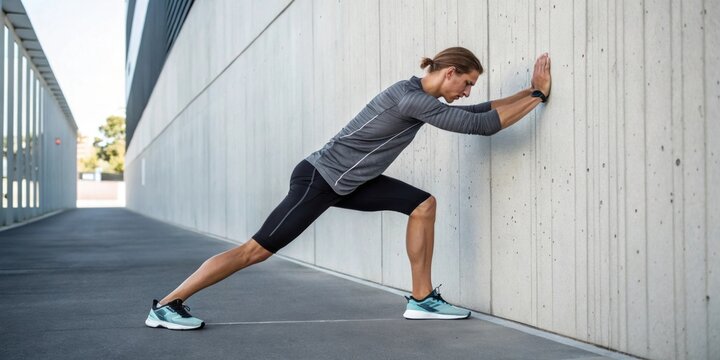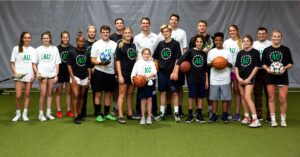After pushing your body through intense speed training, the way you finish your workout is just as important as how you start it. Cool-down stretching helps your body transition from high-intensity work back to a resting state while setting you up for better recovery.
The benefits go beyond just feeling good in the moment. Regular cool-down stretching reduces muscle soreness, improves flexibility over time, and helps prevent the tight spots that can lead to injuries. For speed athletes who put tremendous stress on their muscles and joints, these few minutes of stretching can make the difference between consistent training and time off due to injury.
This guide covers the types of stretches that work best after speed training, which muscle groups to focus on, and a simple routine you can use after every workout. It only takes 10-15 minutes but delivers benefits that last for days.
Introduction to Cool-Down Stretches for Speed Athletes
Why Static Stretching After Training Works
During intense speed work, your muscles contract forcefully and repeatedly. This creates tension and tightness that can linger for hours or even days if not addressed. Cool-down stretching helps muscles return to their resting length and promotes blood flow that aids recovery.
Static stretches—where you hold a position without movement—are perfect for this phase of training. Unlike dynamic stretches used in warm-ups, static stretches help calm your nervous system and allow muscles to relax gradually.
The key is performing these stretches while your muscles are still warm from training. Warm muscles stretch more easily and safely than cold ones, making the post-workout window ideal for improving flexibility.
Target Muscle Groups for Speed Athletes
Speed training heavily involves certain muscle groups that need extra attention during cool-down. The hamstrings work overtime during sprinting and often become tight without proper stretching. Hip flexors get shortened from the high knee drive required for fast running.
The quadriceps handle enormous forces during acceleration and deceleration, while the calves provide power for pushing off the ground with each stride. Your lower back also works hard to maintain posture during high-speed running.
Focusing on these areas during your cool-down addresses the specific demands of speed training and helps maintain the mobility needed for optimal performance.
Example Cool-Down Routine
Light Jog or Walk
Don’t go straight from sprinting to stretching. Start your cool-down with 3-5 minutes of light jogging or walking to gradually bring your heart rate down and keep blood flowing to your muscles.
This transition period helps prevent blood from pooling in your legs and reduces the risk of dizziness or lightheadedness that can occur when you stop intense exercise abruptly.
Use this time to mentally review your workout and begin focusing on the recovery phase. Your breathing should return to near-normal levels before you begin stretching.
Hamstring Stretch
Lie on your back and bring one leg up toward your chest, keeping the knee straight. Hold behind your thigh or calf, depending on your flexibility. You should feel a gentle stretch along the back of your leg.
Keep your other leg flat on the ground and avoid pulling too aggressively. The stretch should feel comfortable, not painful. Switch legs after 20-30 seconds.
This stretch is crucial for speed athletes since tight hamstrings are one of the leading causes of muscle strains in sprinters and other speed sports.
Hip Flexor Stretch
Step into a lunge position with your back foot elevated on a bench or step if available. Allow your hips to sink forward and down to stretch the front of your hip on the back leg.
Keep your torso upright and avoid arching your back excessively. You should feel the stretch in the front of your hip and upper thigh of the back leg.
Hip flexors get extremely tight from the repeated knee drive in sprinting, making this stretch essential for maintaining proper running mechanics.
Quadriceps Stretch
Stand on one leg and pull your other foot toward your glutes, holding your ankle or foot. Keep your knees close together and avoid letting your back arch too much.
If you need help with balance, hold onto a wall or sturdy object with your free hand. Focus on bringing your heel toward your glutes rather than pulling your foot to the side.
Hold for 20-30 seconds, then switch legs. This stretch helps relieve tension from the powerful quadriceps contractions used in acceleration and jumping.
Calf Stretch
Place your hands against a wall and step one foot back, keeping that leg straight and heel on the ground. Lean forward into the wall to stretch your calf muscle.
You can also stretch the deeper soleus muscle by bending your back knee slightly while maintaining the stretch position. Make sure to stretch both the straight-leg and bent-knee positions on each side.
Strong, flexible calves are essential for the push-off phase of sprinting, making this stretch important for maintaining power and preventing Achilles tendon problems.
Lower Back Stretch
Lie on your back and pull both knees to your chest, wrapping your arms around your legs. Gently rock side to side if it feels comfortable.
You can also try bringing one knee across your body toward the opposite side while keeping your shoulders flat on the ground for a gentle spinal twist.
This stretch helps counteract the extension forces placed on your lower back during sprinting and provides relief after intense training sessions.
Complete Cool-Down Summary
- Light jog or walk: 3-5 minutes to transition from high intensity
- Hamstring stretch: 20-30 seconds each leg, lying on back
- Hip flexor stretch: 20-30 seconds each leg in lunge position
- Quadriceps stretch: 20-30 seconds each leg, standing balance
- Calf stretch: 20-30 seconds each leg against wall
- Lower back stretch: 20-30 seconds, knees to chest
- Total time: 10-15 minutes for complete routine
Stretching Guidelines
Hold each stretch for 20-30 seconds, breathing deeply and steadily throughout. Don’t bounce or force the stretch—let your muscles relax gradually into the position.Focus on the sensation of the stretch rather than trying to achieve maximum range of motion. Consistency over time will improve your flexibility more than aggressive stretching in single sessions.
Tips for Getting the Most from Your Cool-Down
Timing Matters
Perform your cool-down stretching immediately after training while your muscles are still warm. Waiting too long allows muscles to cool down and stiffen, making stretching less effective and potentially uncomfortable.
If you can’t stretch right after training, do a brief warm-up before stretching to prepare your muscles. A few minutes of light movement is usually sufficient.
Breathing and Mindset
Use your stretching time to focus on slow, deep breathing. This helps activate your parasympathetic nervous system, which promotes recovery and relaxation.
Try to clear your mind and focus on how your body feels. This mental transition from training mode to recovery mode is just as important as the physical benefits of stretching.
Consistency is Key
The benefits of cool-down stretching accumulate over time. Doing it sporadically won’t provide the same injury prevention and recovery benefits as making it a non-negotiable part of every speed workout.
Even on days when you’re tired or pressed for time, go through at least a shortened version of your routine. Five minutes of stretching is better than none at all.
Track your flexibility and soreness levels over time to see how consistent stretching affects your recovery and performance. Most athletes notice improvements within just a few weeks of regular practice.
Conclusion
A good cool-down routine doesn’t take long, but it makes a huge difference in how your body feels and performs in the days after training. Stretching key muscle groups, breathing deeply, and giving yourself time to recover can help prevent injuries and keep you training at your best week after week.
These 10-15 minutes of post-workout care are an investment in your long-term athletic development. Athletes who prioritize recovery through proper cool-downs often find they can train more consistently and at higher intensities because their bodies are better prepared to handle the stress.
If you want to pair your cool-downs with the right speed and strength workouts for maximum results, Athletes Untapped can connect you with experienced coaches who tailor both training and recovery to your goals. Browse our speed and strength specialists who understand that proper recovery is just as important as the workout itself—it’s like having a personal pit crew dedicated to keeping you running faster, stronger, and healthier every season.




